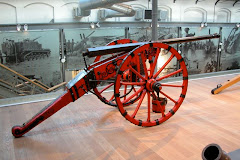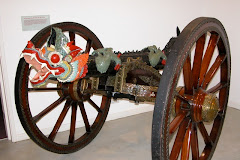Extract of information from Wikipedia:
The Tsar Cannon is an enormous cannon, commissioned in 1586 by Russian Tsar Feodor and cast by Andrey Chokhov.
The cannon weighs 39.312 metric tonnes and has a length of 5.34 m (17.5 ft). Its bronze-cast barrel has a calibre of 890 mm (35.0 in), and an external diameter of 1,200 mm (47.2 in). The Guinness Book of Records lists it as the largest bombard by calibre.
Along with a new carriage, the 1 ton cannonballs surrounding the cannon were added in 1835 and are larger than the diameter of its barrel. According to legend, these cannonballs were manufactured in St. Petersburg, and were intended to be a humorous addition and a symbol of the friendly rivalry between Moscow and St. Petersburg. It was, in fact, designed to fire 800 kg stone grapeshot.
The cannon is decorated with reliefs, including one depicting Tsar Feodor Ivanovich on a horse. The original wooden carriage was made in the early 19th century, but it was destroyed by fire in 1812 when Napoleon descended on Moscow.
Comment:
This seems to be a classic case of 'mine's bigger than yours!' This was a time when an absolute ruler like the Tsar of Russia could demand whatever he wanted, and a bombard like this was more a statement of power than a viable—or even necessary—weapon of war. However, on its original wooden carriage, it could have been used in siege warfare, where its heavy stone shot would have had a powerful effect on the walls of any fortress. It is not known to have been used in any campaign, though there is apparently evidence that it was, at least, tested.
The carriage on which it is mounted now is purely decorative, rather like that of the Bhurtpore Gun in the Royal Artillery collection, now on show at the Royal School of Artillery, Larkhill. It could not be used in action without the severe risk of accident!
It is said that the cannonballs were intended as decoration for this display and even over-sized to make the point. In fact, bombards of this period were actually designed for stone shot or the so-called 'grapeshot' mentioned in the Wikipedia article (though these were not strictly grapeshot because the rocks were not bound together to look like a bunch of grapes, as iron shot were, mainly for naval use). The charge needed to drive the extra weight of full size iron shot would have risked bursting the gun.
That said, this is a magnificent example of bronze casting on a gigantic scale. It is interesting to compare it with the Dardanelles Gun of 630mm calibre, cast by the Turks over 100 years earlier for action at Constantinople in 1453. This gun is currently at Fort Nelson at Portsmouth, but was originally acquired by General Lefroy for the Royal Artillery collection.




